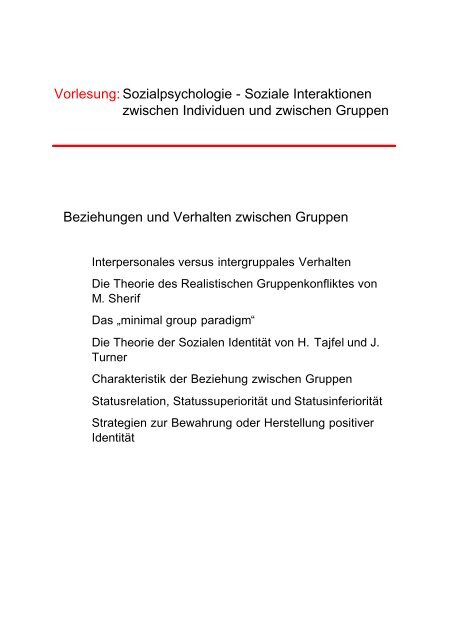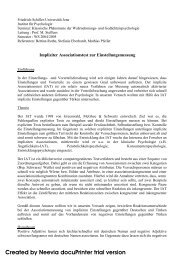Vorlesung: Sozialpsychologie - Soziale Interaktionen zwischen ...
Vorlesung: Sozialpsychologie - Soziale Interaktionen zwischen ...
Vorlesung: Sozialpsychologie - Soziale Interaktionen zwischen ...
Erfolgreiche ePaper selbst erstellen
Machen Sie aus Ihren PDF Publikationen ein blätterbares Flipbook mit unserer einzigartigen Google optimierten e-Paper Software.
<strong>Vorlesung</strong>: <strong>Sozialpsychologie</strong> - <strong>Soziale</strong> <strong>Interaktionen</strong><br />
<strong>zwischen</strong> Individuen und <strong>zwischen</strong> Gruppen<br />
Beziehungen und Verhalten <strong>zwischen</strong> Gruppen<br />
Interpersonales versus intergruppales Verhalten<br />
Die Theorie des Realistischen Gruppenkonfliktes von<br />
M. Sherif<br />
Das „minimal group paradigm“<br />
Die Theorie der <strong>Soziale</strong>n Identität von H. Tajfel und J.<br />
Turner<br />
Charakteristik der Beziehung <strong>zwischen</strong> Gruppen<br />
Statusrelation, Statussuperiorität und Statusinferiorität<br />
Strategien zur Bewahrung oder Herstellung positiver<br />
Identität
VERHALTEN ZWISCHEN SOZIALEN GRUPPEN<br />
„Wann immer Individuen, die zu einer Gruppe gehören, kollektiv<br />
oder individuell mit einer anderen Gruppe oder deren Mitgliedern<br />
interagieren, und zwar in TERMS OF THEIR GROUP<br />
IDENTIFICATION, haben wir den Fall eines Verhaltens <strong>zwischen</strong><br />
Gruppen.“ (SHERIF, 1966, p. 12).<br />
„Verhalten <strong>zwischen</strong> Gruppen ist jedes von einem oder mehreren<br />
Akteuren gegenüber einem oder mehreren anderen gezeigte<br />
Verhalten, das gegründet ist auf der Identifikation der eigenen<br />
Person sowie der Anderen als Angeörige verschiedener sozialer<br />
Kategorien.“ (TAFJEL & TURNER, 1986, p. 15).<br />
„Theorie des REALISTISCHEN GRUPPENKONFLIKTS“<br />
(D. T. CAMPBELL, 1965, p. 287)<br />
Das Verhalten <strong>zwischen</strong> sozialen Gruppen wird bestimmt durch<br />
die FUNKTIONALE BEZIEHUNG <strong>zwischen</strong> den Gruppen: Ein<br />
realer Interessenskonflikt verursacht den Konflikt <strong>zwischen</strong><br />
sozialen Gruppen und damit zusammenhängend Feindseligkeit,<br />
Abwertung der anderen Gruppe, Aufwertung der eigenen Gruppe,<br />
übereinstimmende Interessen (“superordinate goals“),<br />
Abwesenheit von Feindseligkeit.
Table 17.1 The interpersonal-group continuum<br />
Factor Interpersonal Group<br />
Presence of two or more social<br />
categories?<br />
Uniformity of behaviour and<br />
attitudes within one group?<br />
Stereotyped or uniform treatment<br />
of other group members?<br />
Obscured or<br />
not relevant<br />
Clearly visible<br />
and salient<br />
Low High<br />
Low High
THEORIES OF INTERGROUP RELATIONS<br />
Functional tasks requiring<br />
interindividual cooperation<br />
Intergroup competition for<br />
scorce resources<br />
Introduction of<br />
superordinate goals<br />
GROUP<br />
FORMATION<br />
INTERGROUP<br />
CONFLICT<br />
INTERGROUP<br />
COOPERATION<br />
Development of<br />
group “culture“<br />
Biased perceptions: Negative<br />
toward out-group, positive<br />
toward in-group. Emergence<br />
of aggressive leadership<br />
Harmonious intergroup<br />
attitudes<br />
Figure 3.1 Schematic Representation of Realistic Conflict Theory
Figure 10.3 Realistic group conflict theory<br />
Goal relations between individuals and groups determine<br />
cooperative or competitive interdependence, and thus the<br />
nature of interpersonal and intergroup behaviour.<br />
Type of inter-individual relations<br />
Interpersonal<br />
relations<br />
Intergroup<br />
relations<br />
Source based on Sherif 1966<br />
Shared goals:<br />
requiring<br />
interdependence for<br />
their achievement<br />
Interpersonal<br />
cooperation<br />
Group formation/<br />
solidarity<br />
Intergroup<br />
cooperation<br />
Intergroup<br />
harmony<br />
GOAL<br />
Mutually<br />
exclusive goals<br />
Interpersonal<br />
competition<br />
Interpersonal<br />
conflict, reduced<br />
group solidarity,<br />
group collapse<br />
Intergroup<br />
competition<br />
Intergroup<br />
conflict
B o x 10 . 2. THE MINIMAL GROUP PARADIGM<br />
Distribution strategies and sample distribution matrices<br />
(Participants circled pairs of numbers to indicate how they<br />
wished to distribute the points).<br />
A. Two sample distribution matrices. Within each matrices, participants<br />
circle the column of numbers that represents how they would like to<br />
distribute the points (representing real money) in the matrix between<br />
ingroup and outgroup members.<br />
1<br />
.<br />
2<br />
.<br />
Ingroup<br />
member:<br />
Outgroup<br />
member:<br />
Ingroup<br />
member:<br />
Outgroup<br />
member:<br />
7 8 9 10 11 12 13 14 15 16 17 18 19<br />
1 3 5 7 9 11 13 15 17 19 21 23 25<br />
18 17 16 15 14 13 12 11 10 9 8 7 6<br />
5 6 7 8 9 10 11 12 13 14 15 16 17<br />
B. Distribution strategies. From an analysis of responses on a large<br />
number of matrices it is possible to determine the extent to which the<br />
participants´ distribution of points is influenced by each of the<br />
following strategies.<br />
Fairness F Equal distribution of points between<br />
groups<br />
Maximum joint profit MJP Maximise total number of points<br />
obtained by both recipients together,<br />
irrespective of which group receives<br />
most<br />
Maximum ingroup profit MIP Maximise number of points for the<br />
ingroup<br />
Maximum difference MD Maximising the difference in favour<br />
of the ingroup in the number of<br />
points awarded<br />
Favouritism FAV Composite employment of MIP and<br />
MD<br />
Source based on Hogg and Abrams 1988.
Allgemeine Annahmen der Social Identity Theory<br />
„<strong>Soziale</strong> Identität besteht aus den Aspekten des Selbstbildes<br />
eines Individuums, die aus den sozialen Kategorien stammen,<br />
zu denen es sich zugehörig fühlt (Tajfel & Turner, 1986, p. 16).<br />
1. Individuen streben danach, ihr Selbstwertgefühl zu erhalten oder<br />
zu verbessern; sie streben nach einem positiven Selbstkonzept.<br />
2. <strong>Soziale</strong> Gruppen oder Kategorien und die Mitgliedschaft darin<br />
sind mit positiven oder negativen Wertkonnotationen assoziiert.<br />
So kann die soziale Identität eines Individuums positiv oder nega-<br />
tiv sein, je nachdem, wie jene Gruppe, die zur sozialen Identität<br />
eines Individuums beitragen, bewertet werden.<br />
3. Die Bewertung der eigenen Gruppe wird im Bezug auf spezifische<br />
andere Gruppen durch SOZIALE VERGLEICHE auf wertgeladenen<br />
Eigenschaftsdimensionen bestimmt. Positiv abweichende Ver-<br />
gleichsergebnisse <strong>zwischen</strong> ingroup und outgroup bedeuten hohes<br />
Prestige. Negativ diskrepante Vergleiche bedeuten niedriges<br />
Prestige.
Figure 10.6 Social identity theory: belief structures and strategies for<br />
improving social identity<br />
Beliefs about the nature of intergroup relations influence<br />
the general strategies and specific tactics group members<br />
an adopt to try to maintain or achieve positive social identity.<br />
Social<br />
mobility<br />
Social<br />
change<br />
BELIEF<br />
SYSTEM<br />
No cognitive<br />
alternatives<br />
Cognitive<br />
alternatives<br />
TYPE OF STRATEGY<br />
TO IMRPOVE SOCIAL<br />
IDENTITY<br />
Individual<br />
mobility<br />
Social<br />
creativity<br />
Social<br />
competition<br />
SPECIFIC<br />
TACTICS<br />
´Exit` and ´passing`:<br />
assimilation into high<br />
status group<br />
New dimensions of<br />
intergroup<br />
comparison<br />
Redefining value of<br />
existing dimensions<br />
Comparison with different<br />
outgroup(s)<br />
Civil rights activity, political<br />
lobbying, terrorism,<br />
revolution, war, etc.
1. Individuen streben danach, eine positive soziale Identität<br />
zu erlangen oder aufrechtzuerhalten.<br />
2. Positive soziale Identität basiert zu einem grossen Teil<br />
auf günstigen Vergleichen <strong>zwischen</strong> der eigenen Gruppe<br />
und relevanten fremden Gruppen: Die ingroup muss<br />
wahrgenommen werden können als positiv abgehoben<br />
(positively distinct) von den relevanten Fremdgruppen.<br />
3. Wenn die soziale Identität unbefriedigend bewertet wer-<br />
den muss, werden Individuen danach streben, entweder<br />
ihre gegenwärtige ingroup zu verlassen und sich einer<br />
positiver bewerteten Gruppe anzuschliessen und/oder<br />
sie werden versuchen, die positive Distinktheit der<br />
eigenen Gruppe zu erhöhen.<br />
(Tajfel & Turner, 1986)
Figure 4.1 Schematic Representation of Social Identity Theory<br />
INDIVIDUALS STRIVE TO BELONG TO GROUPS<br />
THAT HAVE POSITIVE AND DISTINCT IDENTITIES<br />
INTERGROUP SOCIAL COMPARISONS DETERMINE<br />
WHETHER INDIVIDUAL DERIVES AN:<br />
ADEQUATE SOCIAL IDENTITY INADEQUATE SOCIAL IDENTITY<br />
Attempt to maintain<br />
comparative superiority<br />
Attempt to extend<br />
comparative superiority<br />
Cognitive alternative to intergroup<br />
situation perceived<br />
( Instability - illegitimacy )<br />
Absorption Creativity<br />
Direct Challenge<br />
Redefine Characteristics<br />
SEEK CHANGE<br />
CHANGE-SEEKING STRATEGIES<br />
Individualistic or group strategies,<br />
depending on whether cognitive<br />
alternatives to intergroup situation<br />
are perceived.<br />
Cognitive alternative to intergroup<br />
situation not perceived<br />
( Stability - Legitimacy )<br />
Social<br />
Mobility<br />
Intergroup<br />
Comparison<br />
Taylor, D. M., & Moghaddam, F. M. (1987). Theories of intergroup relations. New York: Praeger, p. 77.
Table 17.3 A matrix used to measure intergroup<br />
differentiation in wage comparisons<br />
(Brown, 1978)<br />
Wages for toolroom group £ 69.30 £ 68.80 £ 68.30 £ 67.80 £ 67.30<br />
Wages for production and<br />
development groups<br />
£ 70.30 £ 69.30 £ 68.30 £ 67.30 £ 66.30
<strong>Vorlesung</strong> „Einführung in die <strong>Sozialpsychologie</strong> II“<br />
Sommersemester 2004<br />
Weiterführende Literatur<br />
Verhalten <strong>zwischen</strong> sozialen Gruppen<br />
Brown,R. & Gaertner, S. (eds.) (2001). Intergroup Processes. In M.<br />
Hewstone & M. Brewer (eds.). Blackwell: Handbook of Social<br />
Psychology, Vol. 3.<br />
Ellemers, N., Spears, R., & Doosje, B. (eds.) (1999). Social<br />
Identity. Oxford. Blackwell.<br />
Sherif, M. (1966). Group Conflict and Cooperation. London:<br />
Routledge and Kegan Paul.<br />
Tajfel, H. (1981). Human Groups and Social Categories.<br />
Cambridge: Cambridge University Press.<br />
Tajfel, H. (1978). Differentiation between Social Groups. Studies in<br />
the Social Psychology of Intergroup Relations. London: Academic<br />
Press.
<strong>Vorlesung</strong> „Einführung in die <strong>Sozialpsychologie</strong> II“<br />
Sommersemester 2004<br />
Weiterführende Literatur<br />
<strong>Soziale</strong>r Einfluss in Gruppen<br />
Eddy van Avermaet (2001). Social influence in small<br />
groups. In M. Hewstone & W. Stroebe (eds.) Introduction<br />
to Social Psychology. Oxford: Blackwell, p. 403-443.<br />
Turner, J. C. (1991). Social Influence. Buckingham: Open<br />
University Press.<br />
Milgram, S. (1974). Obedience to authority. New York:<br />
Harper & Row.
<strong>Vorlesung</strong> „Einführung in die <strong>Sozialpsychologie</strong> II“<br />
Sommersemester 2004<br />
Weiterführende Literatur<br />
Der Einfluss von Minderheiten<br />
Eddy van Avermaet (2001). Social influence in small<br />
groups. In M. Hewstone & W. Stroebe (eds.) Introduction<br />
to Social Psychology. Oxford: Blackwell, p. 403-443.<br />
Moscovici, S. (1976). Social Influence and Social Change.<br />
London: Academic Press.<br />
Mugny, g. (1982). The Power of Minorities. London:<br />
Academic Press.<br />
Turner, J. C. (1991). Social Influence. Buckingham: Open<br />
University Press.









